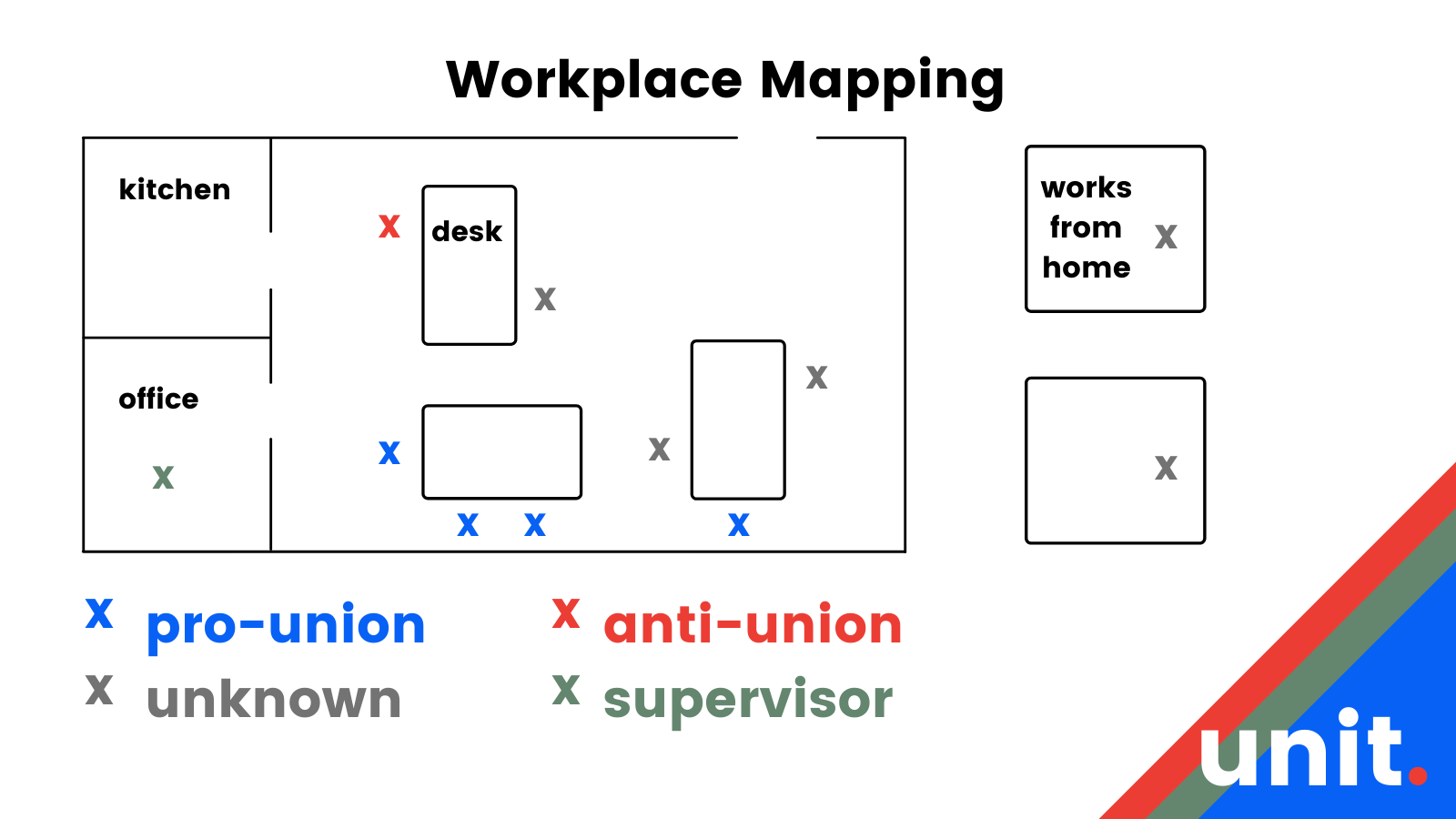Organizing your workplace actually means organizing all the individual workers in your workplace. How can you form a union with your coworkers if you don’t know who they are and what matters to them? You want a clear and accurate picture of where there is support, where outreach is needed, and where there may be anti-union people who need to be neutralized. The labor movement has developed some best practices that include mapping/charting, identifying leaders, and assessing support.
Mapping your workplace
When you’re getting started, mapping can be a useful exercise to make sure you know your workplace. Developing a literal map - one that depicts the different offices and geographic locations, like where people sit in the office or who works near management - helps to develop your expertise of the workplace and can be a fun collaborative project.

Build & maintain your lists
One of the first steps of an organizing committee is to assemble a list of current employees and start to identify who would be included in a union. Start by looking for and reviewing workplace communications like email directories, schedules, organizational maps, and Slack channel members. Keep updating your list as you learn more information on each coworker, including:
- Name (first, last, and preferred name)
- Personal contact info (email/cell phone)
- Job title and department/team
- Location (geographic)
- Workplace issues/notes on conversations
- Union support, like assessments and actions taken
Review this list regularly, there may be remote or part-time employees who would be included in the unit but may not be part of your daily work operations. Don’t forget to add new hires and remove people that no longer work at the organization!

Identify workplace leaders
A leader is someone who has followers - in a union campaign these are the people who can move their coworkers to support or oppose a union. A leader can be someone who is respected by colleagues and/or management because of their work or position in the organization. But that’s not the only criteria! Someone who is outspoken and has advocated for people in the past may be a trusted leader across departments while someone who is an older parent may be regularly sought out for advice by their younger colleagues. Don’t assume you know who your coworkers trust or listen to unless you’ve asked them. Examples of questions to identify leaders:
- Who would you want representing you in this process?
- Who do you think management listens to?
- Who organizes informal happy hours or social events?
- We haven’t talked to anyone in XYZ department yet. If we were to start with one person, who do you think could reach everyone else?
Assessing & tracking union support
Union support is assessed by asking a direct question like, “If we had a union election tomorrow would you vote yes?” You can look at previous union membership, things said in the workplace, etc, to plan your outreach but don’t assume support or opposition - people can surprise you!
Many unions use the following number scale to track support:
1 - Active support/organizing committee member
2 - Supportive but not active, would vote “yes”
3 - On the fence/undecided, “not sure” how they would vote
4 - Doesn’t support the union, would vote “no”
5 - Doesn’t support the union and is actively working against organizing
0 - Unassessed/unreached
Full disclosure, this can be uncomfortable! We don’t always like to ask (or answer) direct questions but losing an election because of inaccurate assessments feels way worse. In order to organize and negotiate a strong contract, people have to talk honestly about their issues and work together to develop solutions. “They seemed into it” is not on the assessment scale for a reason.
Stay organized so you can successfully organize!
Updating assessments after conversations, correcting people’s job titles, making sure you have a complete list of employees - all of these are crucial tasks in a successful campaign. In order to know if there is majority support you need to know the total number of people who would be represented and where they stand on unionizing. And if there is a boss fight or a crisis like layoffs, you want to know that you can reach everyone quickly. Be mindful of how this work is distributed within your committee. All too often, these tasks are undervalued and done by a small group of people (usually women and people of color tbh). Whether you are organizing a union for the first time or you’re organizing to win a contract or issues campaign, you’ve got to know who your people are and how to reach them.
Talk to your coworkers, update your maps and lists, rinse, and repeat!


